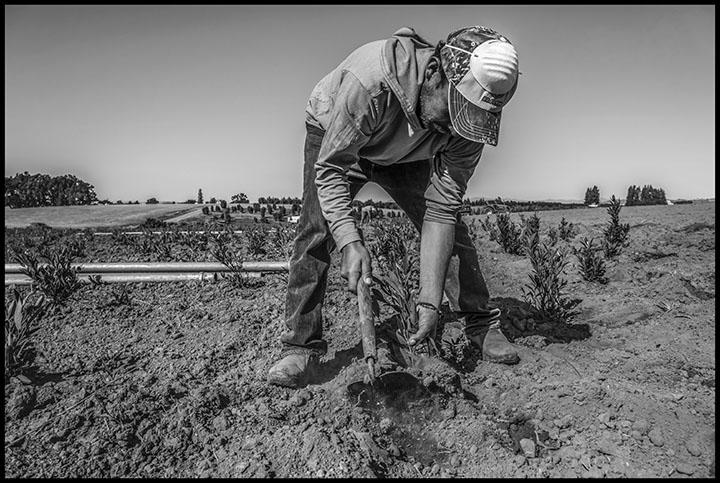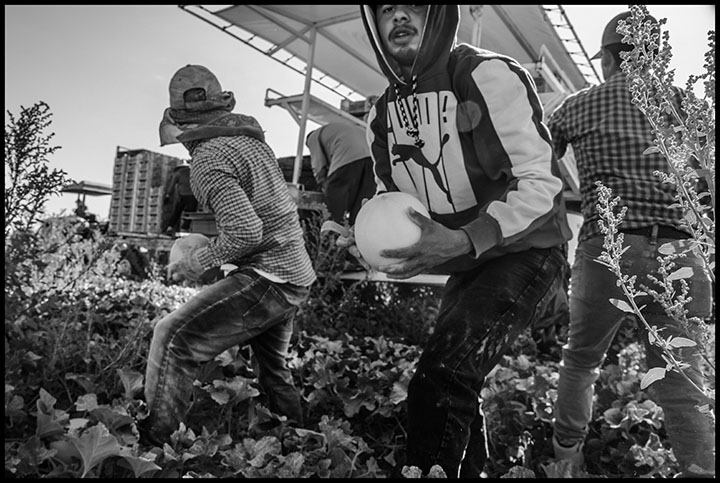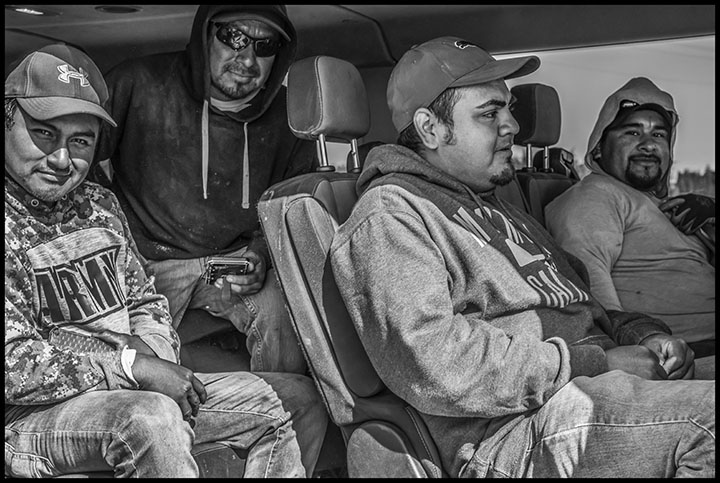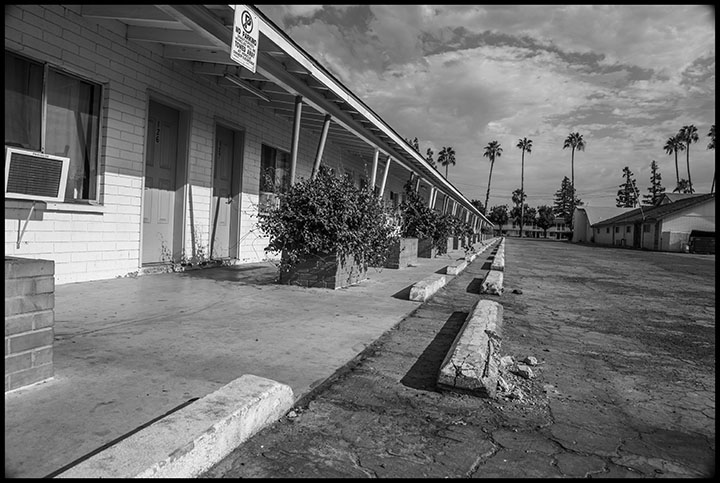The Farm Workforce Modernization Act’s failure to become law reveals critical divisions within the immigrant rights movement.
By David Bacon
The Nation, 1/10/23
https://www.thenation.com/article/activism/farmworker-legalization-failed/

For the United Farm Workers and its allies on Capitol Hill, the failure of the Farm Workforce Modernization Act (FWMA) was a defeat for their campaign to win legal immigration status for undocumented field laborers.
Teresa Romero, UFW President, called it “a very bitter disappointment for farm workers across the country who have more than earned the right to legal status through the sweat of their brow.” She blamed the American Farm Bureau for withholding its support. “They know that an undocumented workforce is easier to intimidate and exploit,” she charged.
“This bill was not perfect and included difficult compromises, but it provided meaningful relief for farmworker families,” said a statement from DC advocate Farmworker Justice, which called Congress’s failure to pass it “inexcusable.”
When the FWMA failed, however, many farmworker organizations outside the Washington, D.C., Beltway felt they’d dodged a bullet. They saw in the bill a boost to the H-2A temporary guestworker program in agriculture, accompanied by immigration enforcement intended to drive undocumented workers from the fields. For Edgar Franks, political director for Familias Unidas por la Justicia, a Washington State farmworker union, “this bill was a gift to growers and gave them things they’ve always wanted. We’ve been speaking out against it for three years-time we should have been able to spend organizing workers-because of the threat of E-Verify and the growth of the H-2A program.”
The bill passed the House two years ago, but got stuck in the Senate, where Republicans refused to support even a torturous process for granting legal status to some undocumented farmworkers. Facing Congress’s adjournment, Colorado Democratic Senator Michael Bennet reintroduced it as the Affordable and Secure Food Act, with more favorable provisions for growers. In a last-minute Hail Mary after failing to obtain a Senate vote on it, the bill’s supporters tried to attach it to the omnibus spending bill. That didn’t work either, and the bill finally died.
Neither the FWMA’s advocates nor its opponents expect that the next Congress, in which right-wing Republicans will dominate the House, will vote for any measure to provide legal status to people without papers, even as a tradeoff for other anti-immigrant or anti-worker provisions. In the wake of its defeat, many activists now call for reassessing the decades old strategy of trading legal status for undocumented immigrants for increased enforcement and guestworkers. Avoiding this tradeoff, they believe, depends on farmworkers having greater political and economic power, and virtually all agricultural unions and workers centers agree that organizing is the key.

The tradeoff compromise
“That reassessment starts with acknowledging that the comprehensive reform compromises, of which the FWMA was only the latest, have all failed over the last quarter-century,” according to Rosalinda Guillen, director of Community2Community, a women-led farmworker group in Washington State.
The Farm Workforce Modernization Act had its origin in negotiations between the United Farm Workers and growers during the Trump administration. They developed a bill that inherited the tradeoff of earlier proposals. It would have allowed undocumented farmworkers to obtain a provisional legal status, in which they would have to continue working in agriculture for up to 10 years before applying for permanent residence. In return, growers got an easier process for bringing to the United States H-2A temporary contract workers, whose wages (pegged at close to minimum wage) would be frozen for a year, and then increased by 3 percent yearly.
A statement by San Joaquin Valley Republican Congressman David Valadao made agribusiness’ interest clear. “Making sure our farmers have access to a legal and reliable workforce and streamlining the process for the future flow of workers is just common sense,” he wrote.
The third element of the tradeoff would have made the use of E-Verify-a system to check the legal status of workers-mandatory in agriculture. Field workers who lack immigration papers would then have been unable to apply for jobs they do every season. Since the Department of Labor estimates that over half of the two million people who labor in the fields are undocumented, the impact on farmworker families would have been enormous. The bill would have given growers an H-2A workforce to continue farming, but would have dealt a bitter blow to the people who worked through the pandemic to put food on the country’s tables.
The vulnerability of H-2A workers makes them an attractive workforce for growers. Workers are recruited by large companies, primarily in Mexico. They work for less than a year, and then go back home. Most depend on returning the following year. They are tied to the grower or contractor who recruits them, and can be legally fired for not meeting exhausting production quotas, or for protesting. There is currently no penalty against employers for these reprisals, and the FWMA would not have imposed any. Fired H-2A workers lose their visas and must leave the country. Recruiters in Mexico then refuse to hire them for a new season of employment.
That vulnerability makes it risky to organize to change conditions, and not just for H-2A workers themselves. If farmworkers living in the United States are not content with low wages, growers can and do replace them with temporary workers. While the law requires hiring local workers first, there is virtually no enforcement and a string of legal cases documents a long history of violations.
The last Senate version, which failed to win inclusion in the spending bill, gave agribusiness a change in the H-2A program it has long wanted: allowing employers to keep H-2A workers in year-round jobs. Current regulations limit the contracts for H-2A workers to temporary jobs of less than a year. Extending this was particularly desired by dairies, where work is less seasonal.
One disabled dairy worker, Servando Jimenez, greeted the failure of the bill in a Labornotes article, calling it “legislation that would make us even more vulnerable…. that ties immigration reform to increased labor exploitation.”
Jimenez described backbreaking work in New York state dairies: “For six years, I woke up each morning at 3:30 a.m. Between myself and two co-workers, we would milk 1,700 cows in six hours, take a 15-minute lunch break, and then repeat the process for another six hours…. The bill would coerce workers to stay in dangerous jobs, even if their bodies can no longer take it, by preying on their hopes for citizenship and a healthy life…. H-2A workers are often even more vulnerable than undocumented workers.”

Ignoring the roots of migration
The FWMA compromise was specific to agriculture, but its general architecture reflects the comprehensive immigration reform proposals of the past two decades. In all these grand compromises, legalization is traded for increased enforcement against the undocumented and immigrant labor programs desired by employers.
This tradeoff strategy was set in place in 1986, with passage of the Immigration Reform and Control Act. That bill provided amnesty for about 3.5 million undocumented people, gave farmworkers a separate legalization program, resurrected a labor visa system from the bracero era, began the process of militarizing the border, and made it a crime for employers to hire undocumented workers.
The 1986 amnesty gave people legal status in a relatively short time, and didn’t condition it on their willingness to work in low-wage jobs. Later tradeoff proposals, however, began treating legal status as a privilege that had to be “earned,” rather than a way to ensure people’s rights and their integration into the communities around them. Supporters of the tradeoff strategy argued that a combination of “earned” legalization and ferocious enforcement against migrants crossing the border, while prohibiting their ability to work, would deter further migration.
Under such policies, however, the number of Mexican migrants in the United States actually increased from about 4.6 to 12.5 million. That flow of people seeking survival continues today. “We need to address the role the US has played in displacing people through free trade agreements and neoliberal economics,” says Edgar Franks.
What went wrong with “earned” legalization
Immigration reform based on providing the labor of migrating people to employers to win their political support, while agreeing to anti-immigrant enforcement to win right-wing votes, never addressed the root causes of migration. The idea of “earned” legalization was intended to create an image of deserving immigrants, but it obscured the true reasons for their presence in the United States. At the same time it made migrants more vulnerable.
Myrna Martinez, director of Fresno’s Pan Valley Institute, affiliated with the American Friends Service Committee, proposes instead an immediate and inclusive amnesty, that legalizes all undocumented people. “The nearly 2.4 million farmworkers in our community have already ‘earned’ a pathway to citizenship through decades of work and contributions to their communities and the US,” she says. Expanding the H-2A visa program and creating a temporary status for workers applying for legalization, she charges, “ignores the experiences of past and present guest workers that have been characterized by extreme exploitation and abuse akin to human trafficking.”
A flawed political strategy has produced these failed tradeoff compromises, and the immigrant rights movement has been deeply divided over them. They are proposals crafted by groups sitting around a table in Washington, D.C., not ones emerging from broad discussions among immigrant and worker groups. In a hostile Congress, the compromises are crafted to get votes from legislators who owe allegiance to employers, who want controlled labor at the lowest possible price. In this process the enforcement lobby, with its stake in detention and border militarization, wields tremendous power.
“From the inception the negotiations over the FWMA weren’t transparent and inclusive of other farmworker organizations or unions,” Franks says. Instead, immigrants and workers are shut out of negotiations, and then presented with a bill as a fait accompli. The tradeoff is treated as the only way to win legal status, which is the only goal, and an increasingly distant one.

Proposing an alternative
This is not a new problem. Gabe Camacho, an AFSC staff person in Boston, called for defeating the comprehensive immigration bill of the Obama era. “We must fight to defeat mandatory E-Verify, new Bracero programs, border militarization, and every other anti-immigrant bill at the state and local level,” he urged. “In the final analysis, the ‘movement’ must be led from outside of Washington, D.C.”
Camacho and the AFSC proposed an alternative at the time, called A New Path. It outlined a radical proposal for immigration reform that included full legalization, a community-based system for migration and reuniting families, labor and political rights for migrants, and a rejection of US policies abroad that cause displacement. The Frente Indigena de Organizaciones Binacionales, an organization of indigenous Mexican migrants and their hometowns, proposed a set of similar rights. Migrants should have the right to equality wherever they go, the group argued, and at the same time the right to not migrate-to an economic and political future in indigenous communities that would end displacement and forced migration.
The defeat of the Farm Workforce Modernization Act creates a moment in which alternatives like these can be debated. “Now we can envision what a real reform would be, one that’s not tied to labor visas, militarizing the border, or detentions and deportations,” Franks argues.
The bill’s opponents, ranging from the Alianza de Mujeres Activas y Solidarias (ALMAS) in Sonoma County and the Mississippi Immigrants Rights Alliance, to the Farmworkers Association of Florida and the Food Chain Workers Alliance, organized a National Day of Action in August.
The Dignity Campaign proposed an immediate alternative: “Eliminate the H-2A program and allow people who want to work in the United States to apply for resident status, with no employment conditions or recruitment by growers,” it urged. “Change the registry date (as HR 8433 does partially), to allow every undocumented person living in the US to apply for permanent residence. Eliminate E-Verify and the prohibition on work for undocumented people, and enforce the labor and human rights of all immigrants.”
In fact, other bills were introduced into the last Congress that would have created broader legalization programs without the tradeoffs. During the pandemic lockdown, California Senator Alex Padilla proposed a legalization program for the essential workers who provided the goods and services that enabled life to continue. In the House, California Representative Zoe Lofgren (also an author of the FWMA) introduced HR 8433 to change the “registry” date. Currently, an undocumented person who has been in the country since 1972 can petition to normalize their immigration status. By advancing that date to seven years after its adoption, the bill would have made it possible for millions of people without papers to get legal status quickly. Organizations like ALMAS and the Coalition for Humane Immigrant Rights of Los Angeles brought delegations of migrants to Washington, D.C., to advocate for it.
Organizing is the answer
Last year, growers were certified to bring in 370,000 H-2A workers-over 13 percent of the US farm workforce, and a number that has doubled in just five years, and tripled in eight.
At the same time, deportations of migrants, who are almost all workers, has increased from 21,046 per year under Ronald Reagan and 33,332 under George H.W. Bush to 383,307 under Barack Obama and 275,725 under Donald Trump. In 1992, fewer than 10,000 H-2A visas were issued. That number tripled by 2005, and under Presidents Obama, Trump, and Biden, it mushroomed. H-2A certifications will soon rival the 450,000 workers recruited in 1954 at the height of the notorious bracero program. That year, the United States deported over a million migrants in “Operation Wetback.”
The immigration measures which did win inclusion in the omnibus spending bill increased border enforcement and maintained the requirement that at least 34,000 immigrants pending deportation be kept in detention center beds every night, a guarantee of profits to the corporations who run the private centers.
With or without the FWMA, this is where the US immigration system is heading if there’s no change on the ground. The movement Gabe Camacho called for must envision a deep change in this system of displacement and exploitation. It must create a democratic process for making concrete proposals. But above all, it must gain the power to force its demands on a capitalist system that resists them.
After the defeat of the FWMA, the Food Chain Workers Alliance warned, “We know there will be continued industry efforts to tie immigration reform to labor exploitation. Grassroots farmworker groups will continue to organize and build power for the farmworker movement and the rights and protections farmworkers deserve.”
For farmworkers, real change requires a much larger base of organized workers. Today, less than 1 percent of the farm labor workforce belongs to unions or worker centers. But while pro-immigrant and pro-worker reforms may be blocked in Washington, D.C., in rural valleys throughout the country the political landscape is changing. Farmworker unions and workers centers are active in many states, including Florida, North Carolina, Ohio, Pennsylvania, New Jersey, Hawaii, and others.
New York State has enacted a law that recognizes the right of farmworkers to join unions and negotiate contracts. Dairy worker Jimenez is now a member of the Workers Center of Central New York, and other farmworker groups, like the Alianza Agricola are organizing migrants.
In Washington State, a series of farmworker strikes, including by H-2A workers, have forced the state to include farmworker unions in the political and regulatory process on issues from protecting local workers from displacement to health and safety during the pandemic. During the Covid era, the organizing activity of Familias Unidas por la Justicia moved inland from the coast, sparking the creation of another independent union in Yakima’s apple packing sheds. Today a UFW strike among Ostrom mushroom workers is fighting against the replacement of local farmworkers and the grower’s use of the H-2A program.
California has implemented a raft of worker protection laws, fought for by the UFW and farmworker advocates. This year, Governor Gavin Newsom was forced to sign a bill he originally vetoed that makes it possible for workers to win union representation rights through a card check process, in which they’re much less vulnerable to grower intimidation.
If the UFW uses the new law to organize more workers and force more growers to bargain, it will raise the living standards of some of the poorest communities in the country. The average income for farmworker families is still about $25,000 per year. That poverty had a devastating impact on the spread of the pandemic among them. Once organized, those workers will win, not just higher wages but also the means to engage in direct action, holding responsible those growers who have opposed their social and political rights.
“Yet again we are reminded,” the UFW’s Teresa Romero pointed out, “why building farm worker power through unionization remains the most urgent strategy in building a truly just food system.”
Leave a Reply